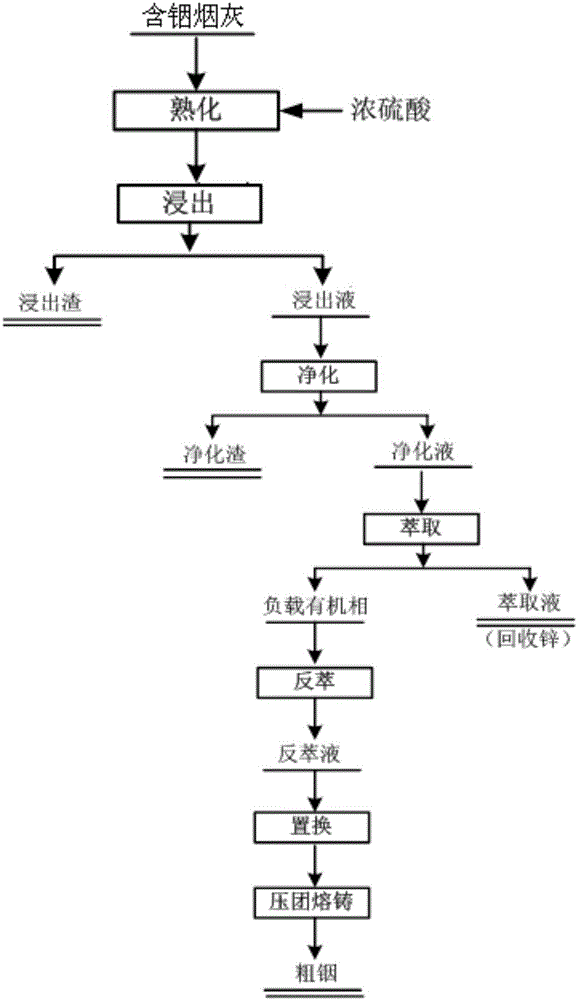Technique for recovering indium from indium-containing soot
A soot and process technology, which is applied to the technical field of recovering indium from indium-containing soot, can solve the problems of low indium recovery rate, waste, indium loss, etc., and achieve the effects of high recovery rate, improving leaching rate, and avoiding loss and waste.
- Summary
- Abstract
- Description
- Claims
- Application Information
AI Technical Summary
Problems solved by technology
Method used
Image
Examples
Embodiment 1
[0042] The process for recovering indium from indium-containing soot in this embodiment includes the following steps:
[0043] Step 1: Mix the indium-containing soot with concentrated sulfuric acid evenly and perform sulfuric acid curing and roasting. The roasting process is: add 20 mL of concentrated sulfuric acid to 20 g of indium-containing soot to perform sulfuric acid curing and roasting. The sulfuric acid curing and roasting time is 2 hours;
[0044] Step 2, leaching the calcined sand produced by sulfuric acid aging and roasting. The calcined sand is leached as follows: add water to the calcined sand and stir in a water bath at 80°C for 2 hours, wherein the liquid-solid ratio of water to calcined sand is 6:1 , and then separate the leaching solution from the leaching residue;
[0045] Step 3, purify the leach solution obtained in step 2 with sodium sulfide. When purifying by sodium sulfide, add a sufficient amount of sodium sulfide to control the acidity of the leach sol...
Embodiment 2
[0051] The process for recovering indium from indium-containing soot in this embodiment includes the following steps:
[0052] Step 1: Mix the indium-containing soot with concentrated sulfuric acid evenly and perform sulfuric acid curing and roasting. The roasting process is: add 15 mL of concentrated sulfuric acid to 20 g of indium-containing soot to perform sulfuric acid curing and roasting. The sulfuric acid curing and roasting time is 1.5 hours;
[0053] Step 2, leaching the calcined sand produced by sulfuric acid aging and roasting. The calcined sand is leached as follows: add water to the calcined sand, stir in a water bath at 90°C for 1 hour, wherein the liquid-solid ratio of water to calcined sand is 3:1 , and then separate the leaching solution from the leaching residue;
[0054] Step 3, use sodium sulfide to purify the leachate obtained in step 2. When purifying by sodium sulfide, add enough sodium sulfide to control the acidity of the leachate to 130g / L, and the tem...
Embodiment 3
[0060] The process for recovering indium from indium-containing soot in this embodiment includes the following steps:
[0061] Step 1: Mix the indium-containing soot with concentrated sulfuric acid evenly and perform sulfuric acid curing and roasting. The roasting process is: add 10 mL of concentrated sulfuric acid to 20 g of indium-containing soot to perform sulfuric acid curing and roasting. The sulfuric acid curing and roasting time is 1 hour;
[0062] Step 2, leaching the calcined sand produced by sulfuric acid aging and roasting. The calcined sand is leached as follows: add water to the calcined sand, and stir in a water bath at 60°C for 1.5h, wherein the liquid-solid ratio of water to the calcined sand is 8: 1. Separate the leachate from the leach residue;
[0063] Step 3, purify the leach solution obtained in step 2 with sodium sulfide. When purifying by sodium sulfide, add a sufficient amount of sodium sulfide to control the acidity of the leach solution to 150g / L, and...
PUM
 Login to View More
Login to View More Abstract
Description
Claims
Application Information
 Login to View More
Login to View More - R&D
- Intellectual Property
- Life Sciences
- Materials
- Tech Scout
- Unparalleled Data Quality
- Higher Quality Content
- 60% Fewer Hallucinations
Browse by: Latest US Patents, China's latest patents, Technical Efficacy Thesaurus, Application Domain, Technology Topic, Popular Technical Reports.
© 2025 PatSnap. All rights reserved.Legal|Privacy policy|Modern Slavery Act Transparency Statement|Sitemap|About US| Contact US: help@patsnap.com

